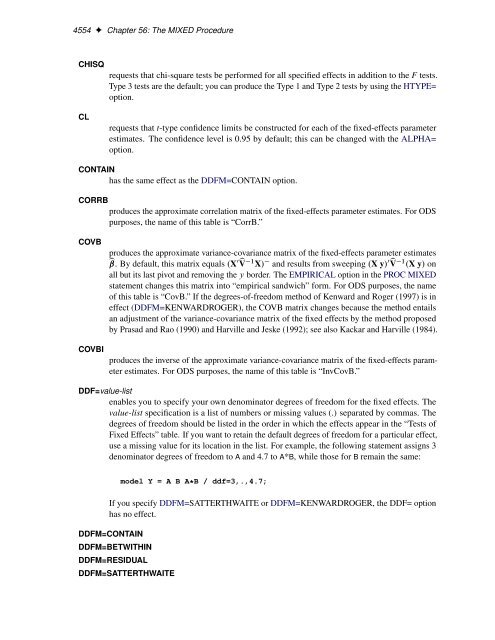SAS/STAT 922 User's Guide: The MIXED Procedure (Book Excerpt)
SAS/STAT 922 User's Guide: The MIXED Procedure (Book Excerpt)
SAS/STAT 922 User's Guide: The MIXED Procedure (Book Excerpt)
Create successful ePaper yourself
Turn your PDF publications into a flip-book with our unique Google optimized e-Paper software.
4554 ✦ Chapter 56: <strong>The</strong> <strong>MIXED</strong> <strong>Procedure</strong><br />
CHISQ<br />
CL<br />
requests that chi-square tests be performed for all specified effects in addition to the F tests.<br />
Type 3 tests are the default; you can produce the Type 1 and Type 2 tests by using the HTYPE=<br />
option.<br />
requests that t-type confidence limits be constructed for each of the fixed-effects parameter<br />
estimates. <strong>The</strong> confidence level is 0.95 by default; this can be changed with the ALPHA=<br />
option.<br />
CONTAIN<br />
has the same effect as the DDFM=CONTAIN option.<br />
CORRB<br />
produces the approximate correlation matrix of the fixed-effects parameter estimates. For ODS<br />
purposes, the name of this table is “CorrB.”<br />
COVB<br />
COVBI<br />
produces the approximate variance-covariance matrix of the fixed-effects parameter estimates<br />
bˇ. By default, this matrix equals .X 0bV 1 X/ and results from sweeping .X y/ 0bV 1 .X y/ on<br />
all but its last pivot and removing the y border. <strong>The</strong> EMPIRICAL option in the PROC <strong>MIXED</strong><br />
statement changes this matrix into “empirical sandwich” form. For ODS purposes, the name<br />
of this table is “CovB.” If the degrees-of-freedom method of Kenward and Roger (1997) is in<br />
effect (DDFM=KENWARDROGER), the COVB matrix changes because the method entails<br />
an adjustment of the variance-covariance matrix of the fixed effects by the method proposed<br />
by Prasad and Rao (1990) and Harville and Jeske (1992); see also Kackar and Harville (1984).<br />
produces the inverse of the approximate variance-covariance matrix of the fixed-effects parameter<br />
estimates. For ODS purposes, the name of this table is “InvCovB.”<br />
DDF=value-list<br />
enables you to specify your own denominator degrees of freedom for the fixed effects. <strong>The</strong><br />
value-list specification is a list of numbers or missing values (.) separated by commas. <strong>The</strong><br />
degrees of freedom should be listed in the order in which the effects appear in the “Tests of<br />
Fixed Effects” table. If you want to retain the default degrees of freedom for a particular effect,<br />
use a missing value for its location in the list. For example, the following statement assigns 3<br />
denominator degrees of freedom to A and 4.7 to A*B, while those for B remain the same:<br />
model Y = A B A*B / ddf=3,.,4.7;<br />
If you specify DDFM=SATTERTHWAITE or DDFM=KENWARDROGER, the DDF= option<br />
has no effect.<br />
DDFM=CONTAIN<br />
DDFM=BETWITHIN<br />
DDFM=RESIDUAL<br />
DDFM=SATTERTHWAITE

















